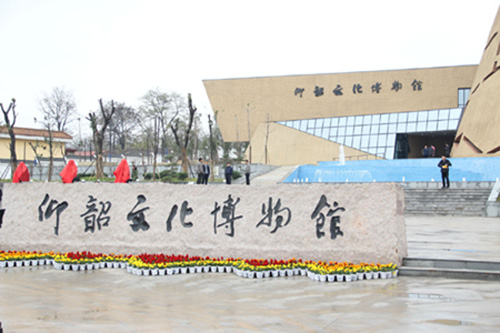
The Yangshao culture (Chinese: 仰韶文化; pinyin: Yǎngsháo wénhuà) was a Neolithic culture that existed extensively along the central Yellow River in China. The Yangshao culture is dated from around 5000 BC to 3000 BC. The culture is named after Yangshao, the first excavated representative village of this culture, which was discovered in 1921 in Henan Province. The culture flourished mainly in the provinces of Henan, Shaanxi and Shanxi.
Yangshao Culture, named after the Yangshao Village in Mianchi, Henan Province, was first discovered in 1921 by Andersson JohanGunnar, a Sweden scholar. The Yangshao Culture covers a wide geographic area and has a history which can be dated back to 7000 to 5000 years ago. The ancestors of the culture created it when they were in as early as the matriclan age, with settled villages and set graveyard, managing their primitive farming with the hoe and raising livestock such as pigs and dogs. Moreover, picking, fishing and hunting activities were also an important part of their lives, together with handicraft industries including pottery making, straw knitting, weaving and bone prodding, etc. Their artworks were the implicit signs of their life, production and religious activities at that time.
Identical cultural characteristics are reflected in nearly 100 cultural sites and relics that have been excavated so far. Polished stone implements are the major production tools, characterized by knife, axe, chisel, arrowhead and stone spindle whorl used for weaving. The bone tools are delicate too. The Yangshao clan also engaged themselves in hunting, fishing and collection; they had advanced agriculture and raised pigs and dogs as their main livestock. Their ceramics thrived too, which can be proved by all sorts of daily potteries unearthed, usually made of red fine clay, including tripod caldrons, bowls, cups, pots, jars and urns. The red potteries were usually drawn with colored geometric or animal patterns, which is the most distinct feature of the Yangshao Culture. That's why it is also called the "Painted-pottery Culture". The ancient painted potteries of the culture are the embodiment of the cultural achievement of Chinese matriclan system in its heyday.
From the Yangshao ruins we could observe compounds with ordered layout. The relics of over 40 houses are unearthed, where there is a big house served as public ground, faced by other dozens of medium and small houses in the shape of a lune. The inhabitants of the culture circle were entombed according to certain burial customs after decease. They were usually buried in a rectangular pit with accompanying articles such as potteries. In a female-centered society like this, women's funerals were ceremonious compared to those of men, and a son shall be buried in the same location with his mother.





Why not rent a boyfriend, or girlfriend to please parents during the Spring Festival?